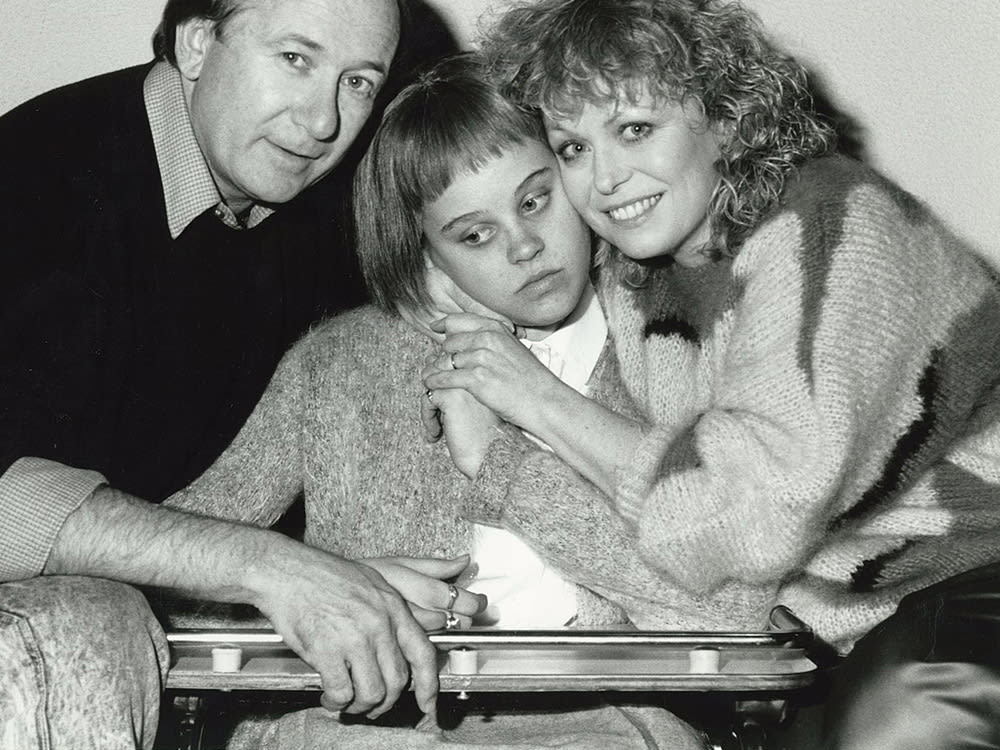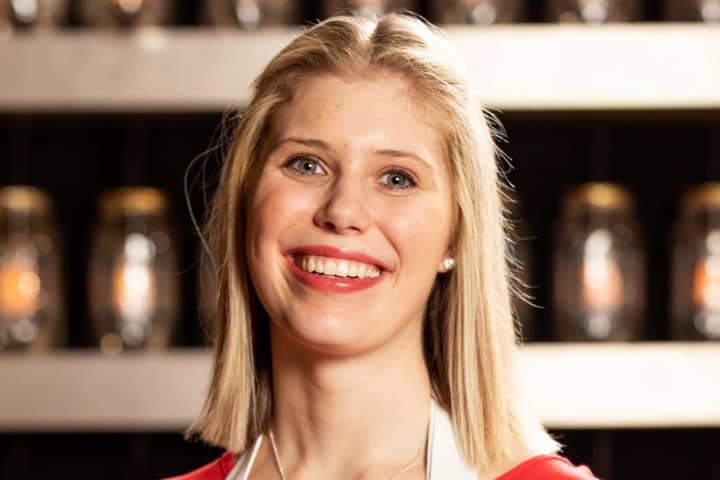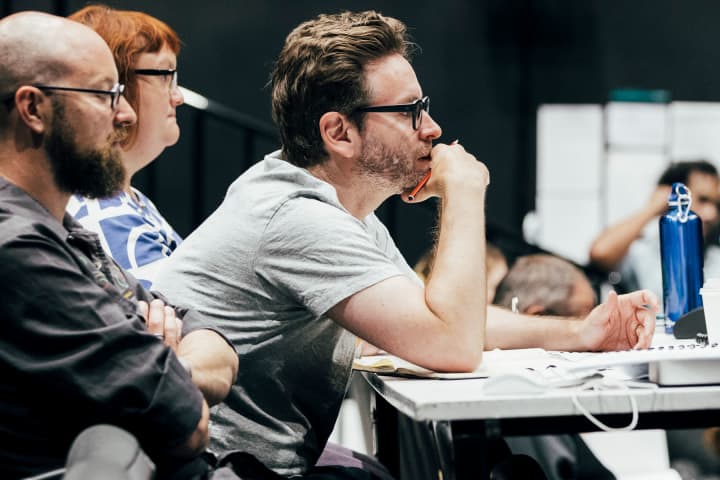Nadine Garner is one of the country’s most revered actors but her performance as Kate in Emerald City marks the first time she will appear in a work by one of our most revered playwrights.
Garner made her stage debut in 1987, the same year David Williamson’s Emerald City was first performed. The then-teenaged actor was already winning over Australian audiences in the beloved television series The Henderson Kids, alongside the likes of Ben Mendelsohn and a pre-Neighbours Kylie Minogue. Williamson, meanwhile, was already a household name, with stage and screen hits including The Removalists, Don’s Party, Gallipoli and Phar Lap under his belt. His semi-autobiographical Emerald City quickly became one of the nation’s most iconic comedies, with five separate productions opening around the country within four months of its premiere, and a film adaptation – starring John Hargreaves, Robyn Nevin, Ruth Cracknell and Nicole Kidman – following within a year. More than three decades later, director Sam Strong has brought actor and playwright together for the first time.

Nadine Garner in 'Private Lives'. Photo: Jeff Busby
Melbourne born and bred Garner studied Emerald City in high school, and recalls how the imagery and themes of the play ignited her adolescent imagination: ‘the play opens with Colin talking about the green and things growing through cracks and that’s exactly my childhood memories of Sydney, of it being so different from Melbourne,’ she says, before noting wryly that it’s different now, ‘because of climate change’.
Emerald City famously skewers the Melbourne–Sydney rivalry that has existed forever, though Garner speculates that Williamson was among the first to give it voice – ‘certainly in a dramatic sense’ – and that this is part of what makes the play so entertaining. ‘It was a very canny thing to do,’ she says. ‘I think it was there underneath the surface but no one had really named it yet, so that’s why it was so enthralling: because he was saying the unspeakable, he was talking about this rivalry.’
A 21st century Emerald City
Things have evolved since then, of course, but while Emerald City is a satirical deep dive into the materialism of the 1980s – the era of ‘greed is good’ and Madonna’s Material Girl – its Faustian themes are timeless. And while Garner’s character, Kate, is emblematic of the contemporary ’80s woman, her concerns are still sharply pertinent for working mothers in 2020: husbands who don’t share the domestic load, bosses who are dismissive of her ideas, and just generally dealing with life in a society full of boorish, chauvinistic men.
‘Kate, for me, is someone I feel like I understand really intuitively,’ Garner says. She imagines Kate as an upper working class, maybe lower middle class, Melbourne-born woman, well-educated and bright. ‘I think she probably knew she wanted to work in publishing quite early. She was one of those bookish kids, and a smart-arse. She probably had a hard time working her way up, and I don’t think she’s had things handed to her on the plate. I think she’s gotten there through her intelligence, and her tenacity.’
Garner also views Kate as having a strong social conscience. ‘Although she’s paradoxical in that she wants to cultivate a comfortable, privileged life for herself and her children, but she also is really deeply affected by people who are going without, or who are struggling. She’s not prepared to be the full-blown socialist and distribute equal wealth for all but she does genuinely have an altruistic sense of wanting to make the world a better place for most people.’

Nadine Garner rehearsing Emerald City. Photo: Charlie Kinross
Through the course of the play, Kate gets promoted to quite a lofty position, with a significant salary increase. ‘So I think we’re seeing the journey of a woman’s ascent, through changing social conditions that are allowing doors to open for women into more executive positions. And I think the play very much rides on that kind of snowballing feeling of a galloping economy where anything’s possible,’ she says, before noting that it’s set in the year of the Black Monday stock market crash that preceded what then treasurer Paul Keating called ‘the recession we had to have’.
While not mentioned in the play, the crash does help demarcate where Kate differs from contemporary working women: the idea of what is middle class has changed since the excess of the late 80s. ‘I think we see ourselves as middle class now because of our education, and the way we view the world, not because of what we own. I don’t think there’s a lot of surplus anymore; there’s none in my life, especially compared to my parents. When I look back on our little life, it was much more middle class than my life now: we had a holiday house and we had two cars. But people will say “what are you worrying about – you’ve still got nice lifestyles and you’re still okay compared to...” And that’s true. But it’s day to day, it’s a hand-to-mouth existence in the middle class for my friends. Especially in the arts.’
State of the arts
Part of the problem, she thinks, is the state of federal funding for the arts: ‘we’ve been under consecutive governments that expect artists to just create out of thin air, and that because we’re passionate about what we do, the work would just keep happening.’ But it also comes down to the fact that ‘there’s a real gap between what it takes to create content and content appearing on people’s phones, for example. People think it just happens. When they turn on their TV, they’ve got no idea what’s behind an episode of Australian drama. How do you teach people the value of that, when it’s so readily available?’
‘I think part of the human condition is that we always want storytelling. What are we as a nation, what are we as a culture, if we are not telling our stories?’
Despite the difficulties, Garner is hopeful. ‘I think part of the human condition is that we always want storytelling. What are we as a nation, what are we as a culture, if we are not telling our stories? And artists are highly skilled people. You only have to look at this Company: to get out the amount of product that they do year in, year out, it requires a highly intelligent, broad-thinking network of skills. And [the industry] generates millions of dollars!’
Garner is grateful every time she gets a job with MTC. ‘When someone is taking risks and trusting you to do the job, you grow enormously. So I just feel really humbled by having the Company come to me with opportunity to grow, and I don’t take that for granted; I know it might disappear at any moment. It is a real privilege.’
A Company woman
The working relationship Garner has with MTC runs deep. Her stage debut was with the Company, in a play called A Day in the Death of Joe Egg, directed by Simon Phillips. During the late 1990s and early 2000s, she had ‘a big chunk of time’ when she was working in television, not on stage. She views her theatrical come back as 2014’s Private Lives, directed by Sam Strong. ‘That was really an amazing production to be part of, because it was so beautiful and he had such a strong modern vision for that show.’

Nadine Garner in her stage debut, MTC's 'A Day in the Death of Joe Egg' with Bruce Myles and Jacki Weaver
Photo: Jeff Busby
Despite feeling ready to step back on stage, Garner admits it ‘was really scary’ – and that it still is. ‘It’s something I’m reminded of now every time I step into a rehearsal space. As an actor you’re never far away from that feeling; you can have one bad day where you don’t feel across the material and you’re back in square one. It’s a very humbling experience. But I kind of like it if you stay in that humble, modest place of “I don't know, and I might not be very good today.” It’s not an easy place to sit, because it’s scary. But it enables you to always be learning from other people on the floor.’
Asked what she’s learned, and what she loves, about theatre, Garner replies: ‘I think what I’ve learned is to never be lulled into this false sense of a) there’s always going to be a job; or b) I’m always going to be good; or c), I’m always going to know how to feel confident in the room. What I love about the theatre is that every time I come back into a show and I create a character, I learn so much about everything – not just about the craft of acting but about how you make things. The learning of the skill and the artistry that have to dance together is a really fascinating thing. There’s this incredible kind of symbiosis happening all the time. The theatre is a sacred space,’ she concludes. ‘And with an audience watching me? That’s a contract; it’s got a sacred overtone that I take really seriously. And I love that.’
Emerald City is on at Southbank Theatre, The Sumner, from 6 March — 18 April 2020
Published on 10 February 2020





